Keywords
Tucumã; EDXRF; Elemental composition; Nutrition; Amazonian fruit
Introduction
It is a notorious worldwide perception that the Amazon is an extremely vast environment that needs more in-depth studies about zoology and botanic, as well as their relations [1]. Observing the botanic of this biome, we can see the enormous potential that regional fruits can arouse. The food industries, pharmaceutical and cosmetic industries have begun to take an interest in this new source of raw matter [2]. Seeking works in the literature, it is clear that little has been properly studied, especially regarding the Amazonian fruits [3]. Although they are beginning to be studied, the focus is mostly on their morphological structures [4] or reproductive properties [5]. Regarding the chemical composition, the studies which are commonly found is about the lipid and protein plant fractions [5,6].
The organic chemical composition of some of them has already been published, but the inorganic part is rarely cited [7]. Arising from this interest and few studies on the chemical composition of regional plants, it is understood that this type of study should be done, because it is an extreme necessity for industrial areas which are above reported [8,9]. With this in mind, this work will study the native fruit known as tucumã.
The plant has great economic importance in the Amazon region, and therefore it has become the study object of many researchers in the fields of botany and agronomy [4-6]. From the plant, almost everything is used, the pulp, for example, is used in cooking in several regional dishes as well as being used by natives as feed for animals [10]. Of the leaves, fibers that are drawn along with the endocarp (seed) are used on a large scale in the production of crafts. Currently the oil extracted from the fruit is undergoing studied in relation to biofuel production, among other applications [11].
In Brazil, there are specific laws governing the presence of metals in natural products marketed. Bioactive oils or plant extracts used as personal care products, cosmetics and perfumes should be free of As, Pb, Cr, Cd, Te, Ta and Sb. In feed, there are maximum limits for the following elements: As, Pb, Cd, Sn, Cu and Hg. Quality control tests for heavy metals should also be indicated for herbal registration [12].
Energy Dispersion X-ray Fluorescence (EDXRF) is a method that has been used in the most varied fields of studies where chemical composition is important [13-15]. EDXRF using a Lithium-Silicon detector is a multi-elementary technique in which a unique quantitative analysis provides data about all the elements present with an atomic number between 11 and 92, that is, between sodium and uranium [16,17]. It is a non-destructive technique, with the possibility of analysis of solid or liquid samples, thick or thin, without pre-treatments, such as acid aperture, which can be a source of contamination and false positives in the analyses [18]. Another interesting point is the ability of the technique to perform a screening of the sample, sweeping the periodic table almost in its entirety in a single analysis and the possibility of a semi-quantitative study [19].
The research was motivated by its unprecedented character, considering that in all literature published until today the whole focus of research was focused on two aspects: the main is the botanical study and the secondary the study of organic composition. The main objective of this research was to study the fruit of the tucumã in order to identify and characterize the inorganic chemical elements that compose it.
Methods
Samples
A total of 30 samples of the fruit of Tucumã (Astrocaryum aculeatum), purchased from street vendors in the city of Manaus-AM, were analyzed. The fruits were sanitized; the shells were removed with stainless steel knife, separated and studied in nature. The analyses were made with all parts of the fruit: shell, pulp, endocarp and seed. These parts were examined as structures closer to the boundaries between them. With this, it was possible to obtain a profile of alteration of the elements along the interior of the fruit.
Spectrometry analyses
For the inorganic composition of the fruit, the analytical technique used was the X-ray fluorescence by energy dispersion, which consists of the excitation of the elements present in the sample by X-rays generated in a Rh tube. All analysis was performed utilizing an EDXRF spectrometer, model EDX-700 from Shimadzu©, belonging to the Laboratory of Tests and Research in Fuels, Federal University of Amazonas. This equipment is capable of detecting Na (Z = 11) to U (Z = 92) elements present in the sample. X-ray data were obtained utilizing a Rhodium tube, with voltage from 0 to 40 KeV, collected after 200s. The medium used was the vacuum. The X-rays emitted by the samples were detected by a silicon semiconductor activated with high resolution Si (Li) lithium, capable of producing electronic pulses proportional to the energies of X-rays. The spectral images were generated in the equipment software itself. All elements were identified by their Kα or Lα energies. The samples were studied in triplicate Figure 1.
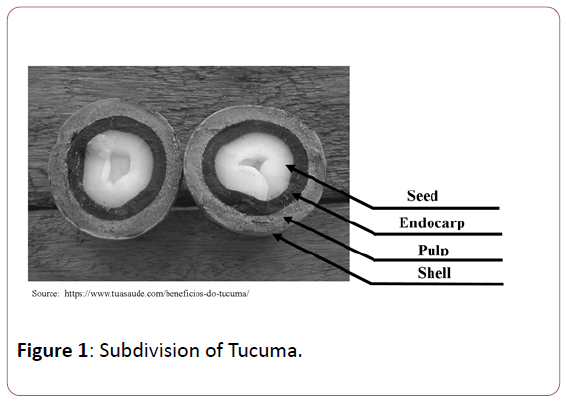
Figure 1: Subdivision of Tucuma.
Results
It is possible to observe that the inorganic chemical composition in the fruit of Tucumã is based on 23 elements: Na, Mg, Al, Si, S, P, K, Ca, Sc, Mn, Fe, Cu, Zn, Rb, Sr, Zr, Y, Cr, Co, Ti, V, Br, Mo. Among them, only 5 were found in all samples: Ca, K, Rb, Cu and Zn.
Some elements could not be quantified because of the lack of standards. The mean values of the elements analyzed in Table 1 are therefore presented.
| |
Na |
Mg |
Al |
Si |
P |
K |
Ca |
Mn |
Cu |
Zn |
Rb |
| Internal Seed |
2.1755 |
0.6865 |
0 |
0 |
1.9842 |
0.0363 |
0.0147 |
0 |
0.0806 |
1.1794 |
0.0027 |
| External Seed |
11.023 |
0 |
0 |
14.4327 |
43435 |
15.0209 |
0.7781 |
0 |
0.0822 |
03937 |
0.004 |
| Internal Endocarp |
8.1006 |
1.1558 |
03633 |
4.5863 |
22.4499 |
5.8799 |
0.7161 |
0.0227 |
0.0805 |
1.105 |
0.0052 |
| External Endocarp |
109696 |
25179 |
2.482 |
4.7071 |
18.1245 |
1.5379 |
0 2715 |
0.012 |
0.083 |
0.7875 |
0.0075 |
| Internal Pulp |
0.4405 |
0 |
0.5671 |
4.5694 |
1.1977 |
6.6644 |
0.4569 |
0.0139 |
0.0805 |
1.18 |
0.0034 |
| External Pulp |
0 |
0 |
0 |
13.7855 |
0 |
7.4191 |
0.955 |
0 |
0.0809 |
0.3936 |
0.0037 |
| Internal Shell |
11.1966 |
1.7432 |
0.6403 |
139521 |
0 |
39781 |
0 2211 |
0.0032 |
0.0818 |
1.1805 |
0.0101 |
| External Shell |
3.1701 |
2.4534 |
13.762 |
0 |
3.9531 |
2.7823 |
0.135 |
0 |
0.0819 |
0.3936 |
0.0076 |
Table 1: Concentration of Elements.
Discussion
The inorganic composition of the fruit is intrinsically linked to the assimilation of nutrients by plants [20]. So the Astrocaryum aculeatum absorbs its mineral nutrients mainly by way of inorganic ions removed from the soil. Among these elements, the division is established in two classes:Macronutrients and Micronutrients [20]. The first is necessary in large quantity, within the standards, for the metabolic functioning of the plant as well as K, Ca, Mg, P, S and Si, and already the second, exemplified by Fe, Mn, Na, Zn, Cu and Mo, in small quantities can perform their functions to assist in the bioprocesses occurring in the organism of the plant [21].
The factor that propitiated some different values was the chemical composition of the Amazonian soil besides the distinct origin of the studied specimens. The pH of the soil is one of the variables that must be taken into account in the absorption of nutrients, since the acidity promotes the weathering of rocks, which in turn releases larger amounts of cations and anions, and further increases the solubility of carbonates, sulfates and phosphates [22].
This fact occurs in the Amazonian ecosystem as a whole. Although there is an abundance of biodiversity in the flora, this is not due to the pH of the Amazonian soil, because its composition is considered as acidic favoring the non-growth of the plants in general [23]. Although the phenomenon described as "litter" promotes soil neutralization by means of decaying organic matrices, which come from fallen dry leaves, fallen mature fruits, among other organic matter [24].
According to the methods, the internal and external study environments were divided into the following parts of the fruit: Seed, Endocarp, Pulp and Bark. Based on the EDXRF analysis, different concentrations were obtained in each of the parts. Graphs 1-3 represent the concentration of the elements found in the plots and their variations. The differences in the intensities of the elements are also related to the function of each part of the fruit.
According to Figure 2 Graph 1, it is observed that the Si is in most parts with the exception of the internal seed and the outer shell. This happens because this element provides some assistance in the structural reinforcement of the plant, increasing the resistance of the cell wall as well as in the regulation of evapotranspiration [23]. The Amazonian soil is composed mainly of latosol and argisol, the Si comes as a common element observed [25].
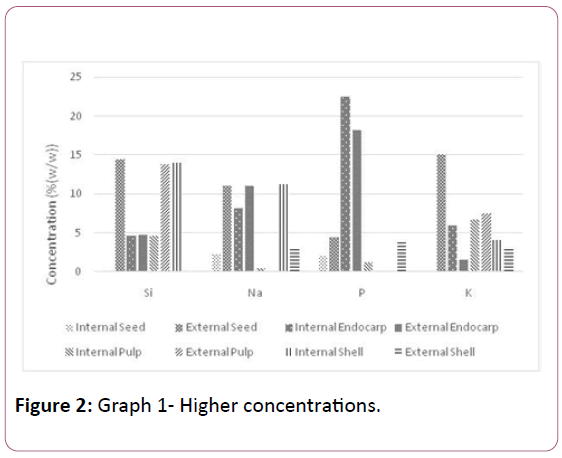
Figure 2: Graph 1- Higher concentrations.
In the case of Na, it has high concentrations in some parts of the tucumã, although it is a micronutrient. However, some plants get better development with considerable amounts of NaCl because the Amazonian soil is acidic. In other words, the high concentration of this ion is inasmuch as the NaCl content in the soil [26].
When it comes to the content of P, this element has five basic functions that justify its presence in the fruit. Two of them manifest their essence from the moment in which the functions of the seed and the endocarp are analyzed, being that of storage of the genetic material, which confers a high amount of phosphorus due to the molecular grouping of DNA and RNA, and the transport and transduction of substrates in order to produce chemical energy in the form of adenosine triphosphate (ATP), respectively [27].
K is present in almost all parts, except in the internal seed, however in the outermost seed a high concentration is observed due to the function of this ion in the fruit, which is the regulation of the osmotic potential causing the inner part does not lose so much water to the external environment [28].
Among the tested concentrations, it is also obtained in a ratio average amount which was shown by Figure 3 Graph 2.
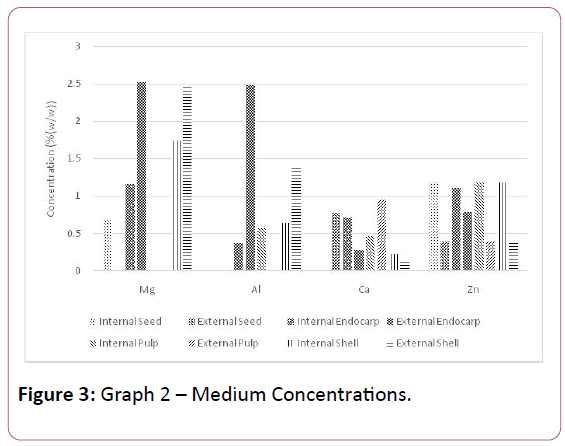
Figure 3: Graph 2 – Medium Concentrations.
It is observed that the concentration of magnesium is justified in the external and internal shell due to the presence in chlorophyll a and b, although it has no biochemical function, this element has the function of maintaining the steric configuration without providing any dysfunctional factor molecule. In the external and internal endocarp and internal seed, the function is that of enzyme activator, mainly because of the energy storage function in the form of ATP in the endocarp [27]. Aluminum is already present in relevance in the external endocarp. Because this ion provides a toxic effect for the plant [20], it is necessary to analyze its concentration in relation to pH level of Amazonian soil according to Table 2 established by Cochrane et al. [28].
| |
P |
K |
Ca |
Mg |
Al |
| pH |
(mg/kg) |
% |
% |
cmol/kg |
% |
| High (>7.3) |
7> |
0,3 |
>4,0 |
> 0,8 |
>1,5 |
| Medium (5.3) |
3 - 7 |
0,15-0,3 |
0,4-4 |
0,2-0,8 |
0,5-1,5 |
| Low (< 5.3) |
<3 |
<0,3 |
<0,4 |
<0,2 |
<0,5 |
Table 2: South American Chemical Soil Concentration.
Considering the pH of the Amazonian soils related to what was established in Table 2, it is seen that the concentration of Al in the soil may have been a crucial factor for the storage of the metal in the fruit [21].
When it comes to Ca, it is observed that it is present in all parts of the fruit, although it is not explicitly stated in the graph visibly, there is a concentration of 0.0147 in the internal seed. The function of this mineral is divided into three, among which the most important is the selectivity of the plasma membrane [20]. In addition, Ca protect against the deleterious effects of Hydrogen ion at an acidic pH such as that of Amazonian soil. Calcium is the only element in which the lack of it promotes immediate dysfunctions [29,30].
Therefore, it can be seen that Zn also appears in the total size of the tucumã. This is due to the effective participation in the active site of many enzymes [31]. Even more precisely, it is observed that the concentration of this micronutrient is lower in all external parts when related to the internal parts. This aspect is due to the fact that zinc is present in proteins that favor DNA transcription. Wherefore their high concentration in the internal seed is justified [27].
In addition, still in relation to Table 1, there is very low concentrations parts whose relations with the tucumã are reported in Figure 4 Graph 3. From this, the Mn is verified very irregularly so that it participates in a process whose purpose is to divide the water molecule with the purpose of releasing the oxygen resulting from a photo-systemic process in the plant [27].
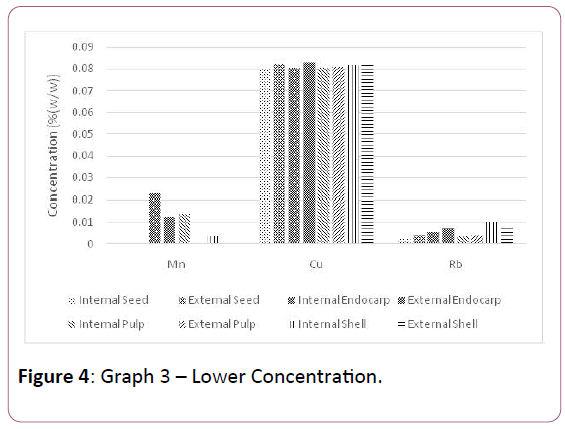
Figure 4: Graph 3 – Lower Concentration.
In a different way, Cu appears throughout the fruit and with a lower standard deviation, conferring a homogeneity in its characterization due to the enzymatic plurality in which the Cu is a part [20]. This mineral is shaped in the plant complex, which functions as electron carrier and capturing the energy resulting from oxidative enzymes and proteins [27] very important for metabolic cellular pathways.
It is also worth mentioning the presence of Rb, which is an element that satisfactorily expresses the root activity of plants because it is considered analogous to K. It can be found in several minerals such as leucite [21].
With consumption much more widespread than the tucumã, another palm fruit much consumed is the coconut, used as a source of proteins, vitamins, fats, carbohydrates and minerals. Because of its high content of mineral salts, popular medicine is recommended to promote physical development, in addition to being widely used as a remedy for its medicinal properties.
Despite the external differences between the two fruits, from the woody endocarp begin the similarities. Both fruits also have a solid milky white endosperm and homogeny. In addition, the water so abundant inside the coconut is also present in the tucumã in quantities proportional to its size [32].
Although only the coconut endosperm is consumed in the diet, this study observed that the endosperm of the tucumã has a higher amount (%/mm) of certain elements such as Ca and K. According to Rodushkin et al. [33], the coconut has about 0.93% K and 0.008% Ca, whereas in this assay the K average was 3.7% and Ca 0.49%.
It should be noted that in both cases the collected samples were obtained from the market and, therefore, may present levels of contamination that may have influenced the result (Figure 5).
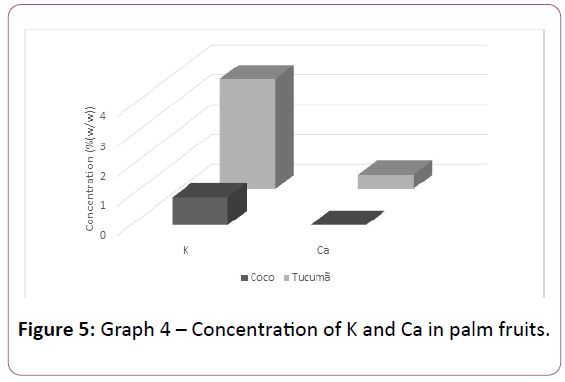
Figure 5: Graph 4 – Concentration of K and Ca in palm fruits.
With the Graph 4, it is observed that there is great variation in relation to both elements between the tucumã and the coconut. Through a nutritional diet based on the need for the corresponding age, it can be inferred that in adolescence; between 19 and 24 years of age and during pregnancy until the 2nd month of lactation, about 1.2 g per day of Ca should be ingested. It is therefore seen that swallowing the tucumã is much more viable than the coconut to support this diet because only 20% of this element is absorbed in the intestine [32].
In the case of potassium, it is seen that the same principle happens. This is due to the fact that the daily diet for children, adults and seniors is identical with a value equal to 2 g. Therefore the ingestion of the tucumã becomes viable also for this element because it has a higher concentration [33].
Conclusion
It was possible to observe that none of the components found are harmful to both plants and humans, therefore demonstrating that it can and should continue to be part of the Amazonian diet. The data collected in the present work can still be used to improve the cultivation of the Astrocaryum palms, since the control of plant growth depends deeply on the nutrients it absorbs.
Acknowledgments
The authors would mind to thank the Crowfoot Group of Research and Amazon State University.
References
- Faulhaber P (2005) The history of research institutes in the Amazon. Advanced Studies: Pp: 241-257.
- Souza Adas GC, Sousa NR, Silva SEL da, Nunes CDM, Canto Ado C, et al. (1996) Fruit trees of the Amazon. Manaus: Embrapa p: 24.
- Loureiro VR (2002) Amazon: a history of losses and damages, a future to (re) build. Advanced Studies: 107-121.
- Gentil DF, Ferreira, Nascimento SA (2005) Seedling morphology in development of the Astrocaryum aculeatum Meyer (Arecaceae). Acta Amazônica: Pp: 337-342.
- Oliveira ME (2008) Biodiesel: Experimental Study of Transesterification Kinetics of Vegetable Oils.
- Bora PS, Narain N, Rocha RM, Monteiro AC, Moreira R de A (2001) Characterization of the oiland protein fractions of tucumã (Astrocaryum vulgare Mart.) fruit pulp and seed kernel. Ciencia y Tecnologia Alimentaria Pp: 111-116.
- Ferreira E de (2008) Physical-Chemical Characterization of Fruit and Oil Extracted from Tucumã (Astrocaryum Vulgare Mart). Nutrition Foods Pp: 427-433.
- Pesce C, Calvacante PB (1996) Edible Fruits of the Amazon. Belém: Editions Cejup p: 71.
- Villachica H (1996) Fruit trees and promising vegetables of the Amazon. Lima: Amazon Cooperation Treaty, Pro-Tempore Secretary pp: 264-267.
- Mendonça MS, Araujo MG (1999) The Bacaba seed (Oenocarpus bacaba Mart.-Arecaceae): Morphological aspects. Braisleira Magazine of Seeds Pp: 122-124.
- Castro J, Figliuolo R, Nunomura S, Silva L, Mendes N, et al. (2006) Sustainable production of biodiesel by Amazonian oleaginous plants in isolated communities. Summaries of the First Congress of the Brazilian Network of Biodiesel Technology.
- Anvisa (2009) RDC 48; Portaria 658; RDC 48.
- Uskokovi?-Markovi? S, Todorovi? M, Mioc UB, Antunovi?-Holclajtner I, Andri? V (2006) EDXFR spectrometry determination of tungsten in tobacco plants after antiviral treatment with 12-tungstophosphoric acid and its compunds. Talanta pp: 301-306.
- Dogan O, T?ra?o?lua E (2006) Determination of potassium, calcium and chlorine in some vegetable by EDXFR. J Quant Spectrosc Radiat Transf pp: 141-145.
- T?ra?o?lua E, Sogutb O, Apayd?na G, Ayl?kc?a V, Damla N (2006) Elemental concentration analysis in some plantt samples by EDXRF at Trabzon. J Quant Spectrosc Radiat Transf pp: 369-401.
- Leyden DE (1984) Fundamentals of X-Ray Spectrometry as Applied to Energy Dispersive Thecniques Tracor X-Ray. California: Mountain View.
- Butin EP (1970) Principles and Practice of X-Ray Spectrometric Analysis. New York: Plenum Publishing Corporation. P: 697.
- Cesareo R, Castellano A, Cuevas AM (1998) Energy dispersive x-ray fluorescence analysis of thin and intermediate environmental samples. X-ray Spectrometry Pp: 257-264.
- Filho HD, Lopes GA (2013). Advances in characterization of crystalline solid samples through. Scientific Station Pp: 31-45.
- Epstein E, Bloom A (2004) Plant Mineral Nutrition: Principles and Perspectives. Sunderland: Sinauer Associates. p: 416.
- Horbe AM, Paiva MR, Motta MB, Horbe MA (2007) Mineralogy and geochemistry of the profiles on neogene and quaternary sediments of the Solimões basin in the region of Coari - AM. Acta Amazonica pp: 81-89.
- Taiz L, Zeiger E (2004) Plant Physiology. Porto Alegre: Artmed. p: 719.
- Fawe AJ, Menzies MC, Belanger RB (2001) Silicon and disease resitance in dicotyledons. Elsevier Pp: 159-169.
- Grupo Verde de Agroecologia e Abelhas (2017) Dry mass dynamics and chemical properties of litter in Virola surinamensis and successional forest in eastern Amazonia. Green Magazine on Agroecology and Sustainable Development pp: 23-28.
- Korndörfer GH, Pereira HS, Camargo MS (2002) Calcium and magnesium silicates in agriculture. Uberlândia: GPSi-ICIAG-UFU p: 23.
- Lombardo U, Denier S, Veit H (2015) Soil properties and pre-Columbian settlement patterns in the Monumental Mounds Region of the Llanos de Moxos, Bolivian Amazon. Soil Pp: 65-81.
- Silva JF, Williams RJ (1991) The Biological Chemistry of the Elements: The Inorganic Chemistry of Life. Oxford: Clarendon Press. p: 561.
- Clarkson DT, Hanson JB (1980) The Mineral Nutrition of Higher Plants. Annual Review of Plant Physiology pp: 239-298.
- Cochrane TT, Sánchez LG, Porras JA, Azavedo LG, Garver CL (1985) Land in Tropical America. Planaltina: International Center for Tropical Agriculture. p: 144.
- Rains DW, Schmid WE, Epstein E (1964) Absorption of cations by roots. Effects of hydrogen ions and essential role of calcium. Plant Physiology pp: 274-278.
- Bowen HJ (1979) Environmental Chemistry of the Elements. London; New York: Academic Press. p: 333.
- Franco G (2007) Table of chemical composition of foods. São Paulo: Editora Atheneu. p: 307.
- RodushkinN I, Engström E, Sörlin D, Baxter D (2008) Levels of inorganic constituents in raw nuts and seeds on the Swedish market. Science of The Total Environment pp: 290-304.






